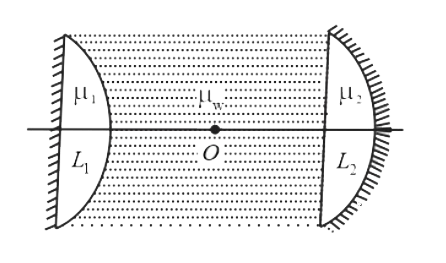In the figure shown, there are two convex lenses L1 and L2 having focal. Lengths f1 and f2 respectively. The distance between L1 and L2 will be

f1
f2
f1+f2
f1−f2
The correct Answer is:C
Step by step video & image solution for In the figure shown, there are two convex lenses L_(1) and L_(2) having focal. Lengths f_(1) and f_(2) respectively. The distance between L_(1) and L_(2) will be by Physics experts to help you in doubts & scoring excellent marks in Class 11 exams.
Updated on:21/07/2023Topper's Solved these Questions
- RAY OPTICSBOOK - DC PANDEY ENGLISHCHAPTER - RAY OPTICSEXERCISE - A. Only one option is correct (JEE Advance)
73 Videos
- RAY OPTICSBOOK - DC PANDEY ENGLISHCHAPTER - RAY OPTICSEXERCISE - B. More than one option is correct
20 Videos
- PROPERTIES OF MATTERBOOK - DC PANDEY ENGLISHCHAPTER - PROPERTIES OF MATTEREXERCISE - Integer
8 Videos
- ROTATIONBOOK - DC PANDEY ENGLISHCHAPTER - ROTATIONEXERCISE - (C) Chapter Exercises
39 Videos
Similar Questions
Two lines L1 and L2 of slops 1 are tangents to y2=4x and x2+2y2=4 respectively, such that the distance d units between L1andL2 is minimum, then the value of d is equal to
View SolutionFigure shows an L-R circuit. When the switch S is closed, the current through resistor R1,R2 and l3 are l1,l2 and l3 respectively. The value of l1,l2 and l3 at t=0 s is
View SolutionTwo thin lenses of focal lengths f1 and f2 are in contact. The focal length of this combination is
View SolutionIn a laboratory four convex lenses L1,L2,L3 and L4 of focal lengths 2,4,6 and 8cm respectively are available. Two of these lenses form a telescope of length 10cm and magnifying power 4 . The objective and eye lenses are
View SolutionThe lines L1:y−x=0 and L2:2x+y=0 intersect the line L3:y+2=0 at P and Q respectively . The bisectors of the acute angle between L1 and L2 intersect L3 at R .
Statement 1 : The ratio PR : RQ equals 2√2:√5
Statement - 2 : In any triangle , bisector of an angle divides the triangle into two similar triangles .
View SolutionTwo rods of length l1 and l2 are made of material whose coefficient of linear expansion are α1 and α2 , respectively. The difference between their lengths will be independent of temperatiure if l1/l2 is to
View SolutionA convex lens L1 and a concave lens L2 have refractive index 32. Match the following two columns.

View SolutionTwo lenses have focal lengths f1 and f2 and their dispersive powers are ω1 and ω2 respectively. They will together form an achromatic combination if
View SolutionA cylindrical tube filled with water (μw=43) is closed at its both ends by two thin, silvered plano - convex lenses, as shown in the figure. Refractive index of lenses L1andL2 and 2.0 and 1.5, while their radii of curvatures are 5 cm and 9 cm, respectively. A point O on the axis of the cylindrical tube. If it is found that all the images formed by multiple refractions and reflections coincide with the object, then the distance between both the lenses is

View Solution(a) Explain with reason, how the power of a diverging lens changes when (i) it is kept in a medium of refractive index greater than that of the lens, (ii) incident red light is replaced by violet light.
(b) Three lenses L1,L2,L3 each of focal length 30 cm are placed co-axially as shown in the figure. An object is held at 60 cm from the optic center of lens L1. The final real image is formal at the focus of L3. Calculate the separation between (i) (L1andL2)and (ii) (L2andL3).
View Solution
